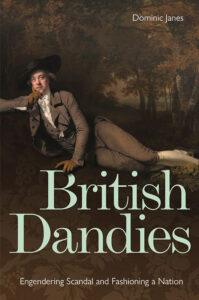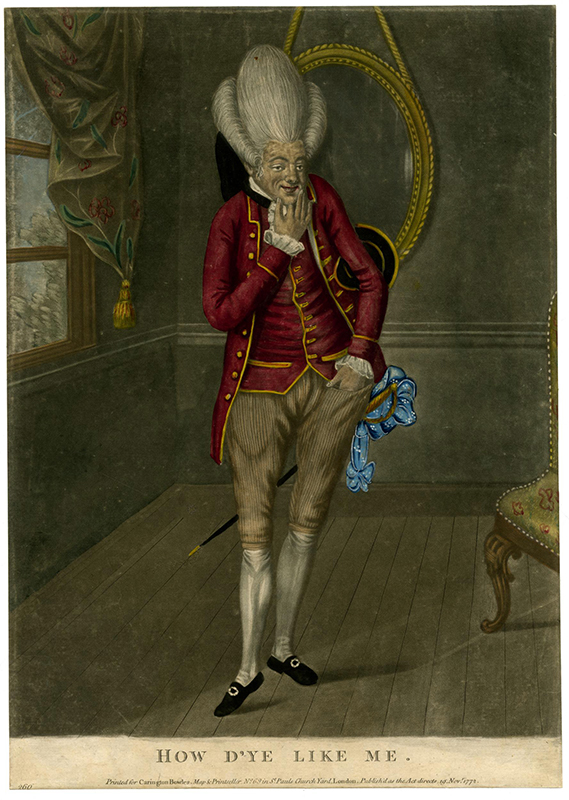The Well-Dressed Man: New Book Focuses on British Dandies
by John-Duane Kingsley
 British Dandies: Engendering A Scandal and Fashioning A Nation by Dominic Janes (The Chicago University Press, 2022) presents a compelling examination of the evolution of the well-dressed man from the 18th through 20th centuries. Sometimes called a macaroni, a dandy, or a fop, these monikers apply to a consistent archetype for men who presented a conscious deviation from dominant fashion in a bid for visibility that ultimately resulted in scandal. Readers who attended Colonial Williamsburg’s Antiques Forum in February 2022 will remember Kate McKinney’s Call It Macaroni lecture on this same topic.
British Dandies: Engendering A Scandal and Fashioning A Nation by Dominic Janes (The Chicago University Press, 2022) presents a compelling examination of the evolution of the well-dressed man from the 18th through 20th centuries. Sometimes called a macaroni, a dandy, or a fop, these monikers apply to a consistent archetype for men who presented a conscious deviation from dominant fashion in a bid for visibility that ultimately resulted in scandal. Readers who attended Colonial Williamsburg’s Antiques Forum in February 2022 will remember Kate McKinney’s Call It Macaroni lecture on this same topic.
Drawing on contemporary accounts in the satirical print media of each period, Janes begins by constructing the archetype of the macaroni as an effete gentleman of means whose resources afforded him French- and Italian-inspired fashions and mannerisms that strongly clashed with British nationalism and the staid conservatism of the British wool broadcloth suit. Macaronis preferred lush pastel colors, metallic threads, towering powdered wigs, and decorative swords that possessed phallic undertones. Although much of the delight of the macaronis comes from a study of their style through the lens of portraiture and print culture, Janes provides a socio-cultural analysis that incorporates visual sources but does not strictly dwell on their visual analysis to convey the spectacle of their clothing. Readers who revel in the stylistic details of period fashion will also enjoy Peter McNeil’s Pretty Gentlemen: Macaroni Men and the Eighteenth Century Fashion World published in 2018.
Aside from the macaroni, Janes traces the evolution of sartorial rebellion through famous dandies of the 19th and 20th centuries. The dandy that evolved from the excess of the macaroni was one of studied restraint that resulted from the sobriety following the French Revolution and subsequent Napoleonic wars. The archetypal Regency dandy was Beau Brummel, an officer in the Tenth Royal Hussars, the personal regiment of Prince of Wales (later George IV). Brummel applied the fastidious nature of military dressing to the precision of his tailoring and constructed his own civilian uniform of a dark blue coat, tight buff trousers and waistcoat, black boots, and a starched white linen shirt with elaborate cravat. Unlike the macaronis, the Regency dandy typified by Brummel was exceptional for their restraint and cleanliness, which defined the “correct” way of dressing, thus engendering less moral panic than the perceived gender fluidity of the macaronis.
In each epoch of this study, the thread connecting these men of fashion is the scandal engendered by their subversive appearance. In the late 19th century, we learn of Oscar Wilde and the panic engendered by his relationship with Lord Alfred Douglas. Janes’s discussion of the 20th century includes a review of the typical characters like Cecil Beaton and Noel Coward, but pays more substantial attention to the adoption of masculine tailoring by women. Within this discussion, Janes frames the symbiotic relationship between female masculinity and male masculinity. Unlike the moral panic that ensued with the feminization of the male ideal posed by the macaronis, the masculine women of the 1920s were not perceived as crossing the gender line, but rather stretching the construct of femininity and, therefore, retaining a degree of cachet. Previous accounts that focus on the evolution of the dandy have rarely incorporated female dandies, so Janes’s discussion presents a valued contribution that deserves further scholarship.
While the figure of the dandy and its evolution are perennially fascinating, the continued study of the archetypal privileged male and his attire does need to evolve and incorporate post-colonial discourse to understand how this archetype functioned across the breadth of the former British Empire. Strides have been made in this arena by Monica Miller in her 2009 text Slaves to Fashion Black Dandyism and the Styling of Black Diasporic Identity, which discussed British and American examples of Black dandyism. Furthermore, given the late-Victorian craze for “orientalism” any iterations of the dandy that represented the hybridity of eastern and western styles deserves expanded analysis.
John-Duane Kingsley is a contributing writer for The Decorative Arts Trust Bulletin. You can read more of his work at www.dandycraft.org.
About The Decorative Arts Trust Bulletin
Formerly known as the "blog,” the Bulletin features new research and scholarship, travelogues, book reviews, and museum and gallery exhibitions. The Bulletin complements The Magazine of the Decorative Arts Trust, our biannual members publication.










